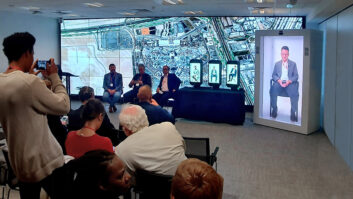
For many of us inside the communications technology industry, we’re at the point now where video calls are the norm. Setting aside how many “video muters” treat video calls as an audio bridge, there’s a larger issue to consider, one where the perception of video conferencing generally sucks (as noted recently at Wired). While video conferencing excels at connecting people, it’s still an underperforming tool for collaborating and getting real work done. We can see and hear each other, but we still struggle when it comes to sharing and seeing each other’s work.
According to HBR, the number of data sources that typical organisations use for making decisions can range from five to more than fifteen. In a typical meeting, collaborators will bring at least one piece of data to the table. Most video conferencing solutions, however, limit how much content can be shared to a single stream from a single device.
Software platforms like Zoom and Skype follow the model of sharing one person’s connected device at a time, as do standards-based room endpoints from makers like Cisco and Polycom. Collaborative workflows are hobbled as people are forced to pass the ball (or dongle). This process is inefficient at best, but the technical hurdles and meeting interruptions can also actively discourage people from sharing. This can lead to uninformed decisions and create problems for teams down the road.
Yet there is a larger confluence of events driving a shift in the way teams work productively together. These trends are pushing leaders to re-examine how their workforce is equipped to optimise performance and engagement. The notions these leaders have about what video conferencing is, and the needs it fulfils, will evolve in 2019.
1. The Exponential Growth of Data
The volume of data accessible to us has outstripped our ability to effectively present and manage it, especially in meeting. Maps, analytics, social media, and both structured and unstructured data must all be considered when decisions need to be made and work needs to get done. Instead of presenting data slide by slide, we need to visualize data side by side so we can more easily compare, cross-reference, and consider our options.
2. The Multi-Location Workforce
The workforce is increasingly more mobile and more distributed. The most effective organisations bring teams together based on their ability to contribute to a project or situation, and not based on their location. Global teams need the ability to work together like they’re in the same room. This means sharing content virtually should be as easy as sharing content around a table. Virtual meetings should allow everyone to share what they need to share, when they need to share so collaboration flows at the speed of conversation.
3. The Millennial Wave
Today, 40 per cent of the workforce is made up of millennials. Within 10 years the number will rise to 75 per cent. This generation of digital natives is not bound by the limitations of traditional workplace paradigms. If they’re not able to contribute to a meeting, they’ll disengage. If the technology provided is having issues, they’ll find alternatives. If they’re bored in the workplace environment, they’ll go elsewhere. They need collaboration technologies that are truly intuitive, exhilarating, and enabling. They need technology that works easily every time. And, they need to use their preferred device and use it from anywhere.
Now’s the time to think beyond basic video conferencing and build towards more advanced solutions to enable more effective and agile ways of working. The video teleconferencing systems proliferating in meeting rooms of all sizes may be getting good use, but there is clear room for improvement. Your most critical meetings are exactly the wrong time to force people to take turns to share knowledge. With multi-stream collaboration and a great UI, meetings flow more naturally, insights are surfaced more seamlessly, and collaborators are more engaged.
Written by DAVID KUNG, VP Product Strategy, Oblong Industries







